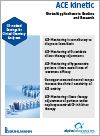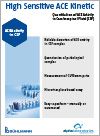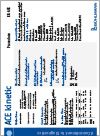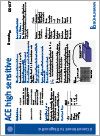Sarcoidosis Diagnosis and Monitoring with ACE
The angiotensin-converting enzyme (ACE) test is primarily used to help diagnose and monitor sarcoidosis.
An inflammatory disease, Sarcoidosis is a multisystem granulomatous disorder of unknown etiology and can be present in any organ system. Most commonly it occurs in lungs, followed by the eyes and integument.
In people with sarcoidosis, abnormal masses or nodules (called granulomas) consisting of inflamed tissues form in certain organs of the body. These granulomas may alter the normal structure and possibly the function of the affected organ(s).
The symptoms of sarcoidosis can vary greatly, depending on which organs are involved. Most patients initially complain of a persistent dry cough, fatigue, and shortness of breath. Other symptoms may include:
Granulomas
A chronic cough or shortness of breath
Red, watery eyes
Joint pain
Angiotensin Converting Enzyme (ACE) Test
In vivo, ACE catalyses the conversion of Angiotensin I to Angiotensin II and inactivates bradykinin during regulating blood pressure via Renin-Angiotensin-System.
Elevated levels of serum ACE have been measured in patients suffering from various disorders. They often indicate a poor prognosis or rapid progression of the disease. Elevated serum ACE levels are reported in granulomatous-inflammatory diseases such as Sarcoidosis and Mixed-Connective-Tissue Disease (MTCD), Nephropathies associated with Diabetes and Glomerulonephritis, Cardiovascular diseases such as left ventricular hypertrophy, brain and myocardial infarction.
The angiotensin-converting enzyme (ACE) test is primarily ordered to help diagnose and monitor sarcoidosis. The cells surrounding granulomas can produce increased amounts of ACE and the blood level of ACE may increase when sarcoidosis is present. ACE will be elevated in 50% to 80% of those with active sarcoidosis.

Benefits
The blood level of ACE tends to rise and fall with disease activity. If ACE is initially elevated in someone with sarcoidosis, the ACE test can be used to monitor the course of the disease and the effectiveness of corticosteroid treatment.
A health practitioner may order ACE along with other tests, such as AFB tests that detect mycobacterial infections or fungal tests. This may help to differentiate between sarcoidosis and another condition causing granuloma formation.
The positive predictive value of elevated ACE activity is estimated between 75-90%, the negative predicted value between 70-80%.
BÜHLMANN ACE Assays
ACE KINETIC
Direct and quantitative determination of Angiotensin Converting Enzyme (ACE) activity. The ACE kinetic assay allows clinical routine laboratories the measurement of the enzyme activity in serum with an easy to use procedure on most open clinical chemistry platforms.
Validated protocols are provided with a complete reagent package including calibrator and controls.
ACE HIGH SENSITIVE
Reliable and sensitive quantification of ACE activity in Cerebrospinal fluid (CSF) is still a challenge. BÜHLMANN provides the first commercial CE marked and non-radioactive tool, allowing reliable ACE determination in CSF.
Used for suspected and confirmed patients with neurosarcoidosis, a long-term (chronic) disease of the central nervous system, which encompasses the brain, spinal cord and optic nerve, and is characterized by inflammation within one or more of those areas.



